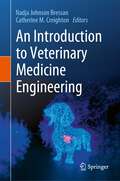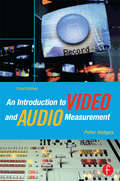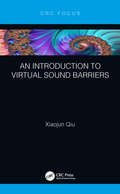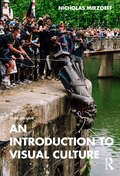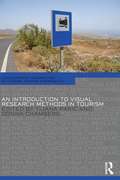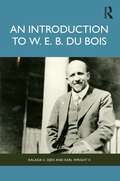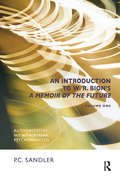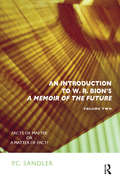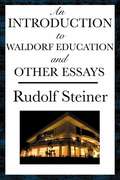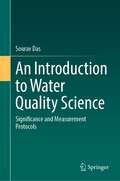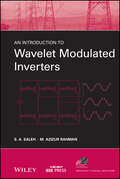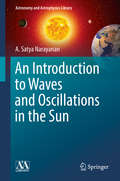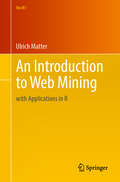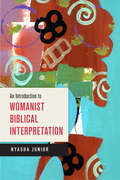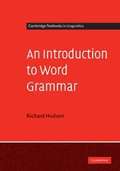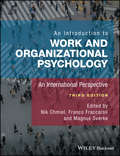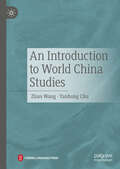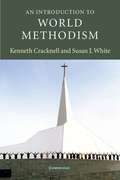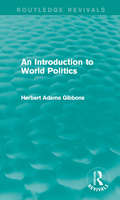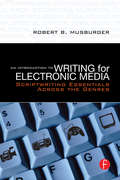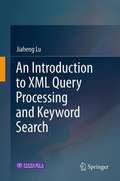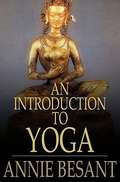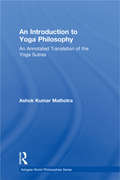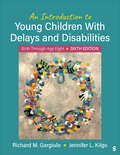- Table View
- List View
An Introduction to Veterinary Medicine Engineering
by Nadja Johnson Bressan Catherine M. CreightonDo cephalopods change color when under distress? Is the reptilian heart analogous to a diaphragm positive displacement pump? Are digital twins the answer for animal experimentation? This book explores the new field of veterinary engineering science and discusses how to better measure vital signs in exotic and companion animals. A vast opportunity exists for developing novel technologies that target reductions to the number of invasive procedures patients are subjected to. We examine improvements to animal care and enhancement of animal welfare while creating a more sustainable veterinary healthcare ecosystem. The authors address the challenges engineers face in designing healthcare equipment for animals and how the field of veterinary engineering contributes to traditional veterinary medicine. This book brings a novel field of engineering to train future veterinarians and engineers on design and application of technology to veterinary medicine.Serves as a learning resource for the training and education of veterinary students, veterinarians and engineersDemonstrates through experiments and case studies the merging point between engineering and veterinary medicineDiscusses concepts and issues associated with engineering and veterinary medicineIllustrates veterinary challenges using an engineering-design approachProvides examples of veterinary applications with successful outcomes, incorporating step-by-step directions for engineers
An Introduction to Video and Audio Measurement
by Peter HodgesWhat do we measure and why? Peter Hodges explains the answer to this question in approachable language and with clear illustrations. Newcomers to the video industry, as well as those already established, will find this uniquely readable guide to the basics of a complex subject. Building on the success of the two previous editions of this popular title and covering both analog and digital video, the third edition includes new sections on audio measurement, high definition video, and innovative techniques of test and measurement.
An Introduction to Virtual Sound Barriers
by Xiaojun QiuA virtual sound barrier is an active noise control system that uses arrays of loudspeakers and microphones to create a useful size of quiet zone and can be used to reduce sound propagation, radiation, or transmission from noise sources or to reduce noise level around people in a noisy environment. This book introduces the history, principle, and design methods of virtual sound barriers first, and then describes recent progress in research on the systems. Two virtual sound barrier systems, i.e., planar virtual sound barrier system and three-dimensional virtual sound barrier system, are discussed including applications, limitations and future direction discussions.
An Introduction to Visual Culture
by Nicholas MirzoeffIn the fully rewritten third edition of this classic text, Nicholas Mirzoeff introduces visual culture as visual activism, or activating the visible. In this view, visual culture is a practice: a way of doing, making, and seeing. The 12 new chapters begin with five foundational concepts, including Indigenous ways of seeing, visual activism in the wake of slavery, and unfixing the gaze. The second section outlines three currently successful tactics of visual activism: removal of statues and monuments; restitution of cultural property; and practices of repair and reparations. The final section addresses catastrophe and trauma, from Palestine’s Nakba to the climate disaster and the intersections of plague and war. Each section also includes new, in-depth case studies called "Visualizations," ranging from oil painting to Kongo power figures and the mediated practice of taking a knee. Engaging with questions of racializing, colonialism, and undoing gender throughout, this edition maps the activist turn in the field since 2014 and sets directions for its future expansion. This is a key text in visual culture studies and an essential resource for research and teaching in the field.
An Introduction to Visual Research Methods in Tourism (Contemporary Geographies of Leisure, Tourism and Mobility)
by Donna Chambers Tijana RakićAn Introduction to Visual Research Methods in Tourism is the first book to present, discuss and promote the use of a range of visual methods in tourism studies. It introduces methods ranging from the collection of secondary visual materials for the purposes of analysis (such as postcards, tourism brochures, and websites) and the creation of visuals in the context of primary research (such as photography, video and drawings), to the production of data through photo-elicitation techniques. The book promotes thoroughly underpinned interdisciplinary visual tourism research and includes an exploration of many key philosophical, methodological and inter-disciplinary approaches. Comprised of five parts: introduction; paradigms, academic disciplines and theory; methods; analysis and representation; and conclusion. This volume informs and inspires its readers through a reliance on theory, examples from tourism studies conducted in various geographical locations and through key pedagogical features such as annotated further readings, practical tips boxes and concise chapter summaries. This book will be of interest to experienced visual tourism researchers, scholars wishing to incorporate visual methods in their studies of tourism for the very first time, as well as students on undergraduate, postgraduate or doctoral programmes who are contemplating the incorporation of visual methods in their studies of tourism.
An Introduction to W. E. B. Du Bois
by Earl Wright II Kalasia S. OjehAn Introduction to W. E. B. Du Bois examines the historical contributions to social science and the continuing relevance of the work of W. E. B. Du Bois in an accessible manner. The first volume of its kind, it places the theories of Du Bois in context, showing how the socio‑racial environment in which he grew up and came of age influenced the development of his thought. In addition to covering well‑known concepts such as double consciousness, the veil, and religious fatalism, the authors discuss Du Bois’ uncoined theories emanating from the Atlanta University Studies, as well as his contributions to the development of Black sociology and research methodology. A groundbreaking contextualization and summary of the importance of Du Bois’ work to sociology and sociological theory, this book constitutes a much‑needed resource for scholars and students seeking to understand this scholar’s significance to the social sciences beyond the elementary level.
An Introduction to W.R. Bion's 'A Memoir of the Future': Authoritative, Not Authoritarian, Psychoanalysis
by P.C. SandlerIn the last years of his life Bion gathered unusual manuscripts handwritten in his tidy lettering that assumed the form of a trilogy. Finely typed and edited by his dedicated wife, they were named A Memoir of the Future. Many of the themes of this book were already evident in Transformations and Attention and Interpretation. These earlier books provide many of the theories whose practical counterpart finally found a form in the trilogy: as Bion himself noted, "the criteria for a psychoanalytic paper are that it should stimulate in the reader the emotional experience that the writer intends, that its power to stimulate should be durable, and that the emotional experience thus stimulated should be an accurate representation of the psychoanalytic experience that stimulated the writer in first place." Was Bion true to his word? It is perhaps left to the reader to answer this question. The present book is an attempt to indicate the view that Bion's attempt was to present the burning flame itself - rather than presenting static photographs of the fire.
An Introduction to W.R. Bion's 'A Memoir of the Future': Facts of Matter or a Matter of Fact?
by P.C. SandlerIn the last years of his life Bion gathered unusual manuscripts handwritten in his tidy lettering that assumed the form of a trilogy. Finely typed and edited by his dedicated wife, they were named A Memoir of the Future. Many of the themes of this book were already evident in Transformations and Attention and Interpretation. These earlier books provide many of the theories whose practical counterpart finally found a form in the trilogy: as Bion himself noted, "the criteria for a psychoanalytic paper are that it should stimulate in the reader the emotional experience that the writer intends, that its power to stimulate should be durable, and that the emotional experience thus stimulated should be an accurate representation of the psychoanalytic experience that stimulated the writer in first place." In this second volume of a much needed introduction to Bion's last work, A Memoir of the Future, Paulo Cesar Sandler continues his detailed and insightful "prelude" to a work many readers have found "obscure, complicated and difficult".
An Introduction to Waldorf Education and Other Essays
by Rudolf SteinerCollected here are fourteen essays by Rudolf Steiner covering subjects such as Waldorf Education, The Reordering of Society, The Human Soul, Karma, and Knowledge. These essays are informative and lively. Rudolf Steiner was an Austrian philosopher, literary scholar, educator, artist, playwright, social thinker, and esotericist. His contributions to society were immense.
An Introduction to Water Quality Science: Significance and Measurement Protocols
by Sourav DasThis book discusses the significance of water quality parameters in aquatic ecosystems, offering a concise and practical measurement methodology for early career researchers and post-graduate students in the fields of environmental science, oceanography, and aquatic science . The keys topics covered include aquatic sampling, basics of physicochemical properties and carbonate chemistry of aquatic science , the importance of nutrients in natural water bodies, biological productivity in aquatic ecosystems, aquatic pollution, and statistical analyses of different types of water science data. Several parameters such as microplastics, dimethylsulfoniopropionate and polychlorinated biphenyls have also been incorporated in the book for comprehensive coverage of the topic. The book is meant as a practical guide for beginners and young researchers using a clear writing style and practical examples, highlighting the significance of water science parameters and their measurement protocols in aquatic environments.
An Introduction to Wavelet Modulated Inverters, 1st Edition
by S. A. Saleh M. Azizur RahmanThe introductory chapter briefly presents the fundamental topologies and operation of power inverters. The second chapter contains a description of wavelet basis functions and sampling theory with particular reference to the switching model of inverters. Chapter three outlines the connection between the non-uniform sampling theorem and wavelet functions to develop an ideal sampling-reconstruction process to operate an inverter for obtaining its optimal performances. The scale based linearly combined basis functions are developed in chapter four in order to successfully operate single phase wavelet modulated inverters. Chapter four also contains the development of the non-dyadic type multiresolution analysis, that are responsible for sampling and recontruction of three continuous time reference modulating signals for three phase inverters. The performances of single phase wavelet modulated inverters for static, dynamic and non-linear loads are presented in chapter five, while chapter six contains the simulation and experimental performances of three phase wavelet modulated voltage source inverters for different loads at various operating conditions. This book presents the latest technology in the advancing power electronics field.
An Introduction to Waves and Oscillations in the Sun (Astronomy and Astrophysics Library #400)
by A. Satya Narayanan"An Introduction to Waves and Oscillations in the Sun" is intended for students and researchers who work in the area of solar and astrophysics. This book contains an introduction to the Sun, basics of electrodynamics, magneto-hydrodynamics for force-free and current-free fields. It deals with waves in uniform media with relevance to sound waves and Alfven waves, and with waves in non-uniform media like surface waves or waves in a slab and cylindrical geometry. It also touches on instabilities in fluids and observational signatures of oscillations. Finally, there is an introduction to the area of helio-seismology, which deals with the internal structure of the Sun.
An Introduction to Web Mining: with Applications in R (Use R!)
by Ulrich MatterThis book is devoted to the art and science of web mining — showing how the world's largest information source can be turned into structured, research-ready data. Drawing on many years of teaching graduate courses on Web Mining and on numerous large-scale research projects in web mining contexts, the author provides clear explanations of key web technologies combined with hands-on R tutorials that work in the real world — and keep working as the web evolves. Through the book, readers will learn how to - scrape static and dynamic/JavaScript-heavy websites - use web APIs for structured data extraction from web sources - build fault-tolerant crawlers and cloud-based scraping pipelines - navigate CAPTCHAs, rate limits, and authentication hurdles - integrate AI-driven tools to speed up every stage of the workflow - apply ethical, legal, and scientific guidelines to their web mining activities Part I explains why web data matters and leads the reader through a first &“hello-scrape&” in R while introducing HTML, HTTP, and CSS. Part II explores how the modern web works and shows, step by step, how to move from scraping static pages to collecting data from APIs and JavaScript-driven sites. Part III focuses on scaling up: building reliable crawlers, dealing with log-ins and CAPTCHAs, using cloud resources, and adding AI helpers. Part IV looks at ethical, legal, and research standards, offering checklists and case studies, enabling the reader to make responsible choices. Together, these parts give a clear path from small experiments to large-scale projects. This valuable guide is written for a wide readership — from graduate students taking their first steps in data science to seasoned researchers and analysts in economics, social science, business, and public policy. It will be a lasting reference for anyone with an interest in extracting insight from the web — whether working in academia, industry, or the public sector.
An Introduction to Womanist Biblical Interpretation
by Nyasha JuniorAn Introduction to Womanist Biblical Interpretation provides a much-needed introduction to womanist approaches to biblical interpretation. It argues that womanist biblical interpretation is not simply a byproduct of feminist biblical interpretation but part of a distinctive tradition of African American women's engagement with biblical texts. While womanist biblical interpretation is relatively new in the development of academic biblical studies, African American women are not newcomers to biblical interpretation. Written in an accessible style, this volume highlights the importance of both the Bible and race in the development of feminism and the emergence of womanism. It provides a history of feminist biblical interpretation and discusses the current state of womanist biblical interpretation as well as critical issues related to its development and future. Although some African American women identify themselves as "womanists," the term, its usage, its features, and its connection to feminism remain widely misunderstood. This excellent textbook is perfect for helping to introduce readers to the development and applications of womanist biblical interpretation.
An Introduction to Word Grammar
by Richard HudsonWord grammar is a theory of language structure and is based on the assumption that language, and indeed the whole of knowledge, is a network, and that virtually all of knowledge is learned. It combines the psychological insights of cognitive linguistics with the rigour of more formal theories. This textbook spans a broad range of topics from prototypes, activation and default inheritance to the details of syntactic, morphological and semantic structure. It introduces elementary ideas from cognitive science and uses them to explain the structure of language including a survey of English grammar.
An Introduction to Work and Organizational Psychology: An International Perspective
by Franco Fraccaroli Magnus Sverke Nik ChmielThis fully updated edition of a best-selling textbook provides the most comprehensive introduction to issues in work and organizational psychology with an international perspective; reflecting current advancements in the workplace, the book brings together the expertise of leading thinkers and practitioners. Fully updated third edition of the best-selling textbook on work and organizational psychology now with an international perspective Presents a solid foundation on a range of core topics including working with technology, the impact on employees when organizations change, and maintaining the work-life balance Updated throughout to include recently emerging themes and current views in the field Includes five new case studies covering age management, diversity at the top, resilience development, respect at work and a strategic approach to improving wellbeing in the workplace Provides instructor and student support includes key studies, research close-ups, discussion points and five extensive case studies
An Introduction to Working with the Aging Person Who Is Visually Handicapped (2nd edition)
by Dava GraysonThis book deals with aged blind persons, the ways and means of lending them a helping hand, services available to them, and solving other problems.
An Introduction to World China Studies
by Zhan Wang Yanhong ChuThis book examines the seven key issues related to China, which have been identified by experts over the past few centuries. The topics addressed include China's impact on international discourse, the inheritance of Chinese civilization, the great divergence between Chinese and Western histories, Kondratiev Cycle Theory, the socialist system and its future prospects, the Chinese path to modernization, and the Belt and Road Initiative. The authors explore these issues within the broader context of human civilization and the evolving global landscape, offering systematic explanations for each topic and redefining the concepts of World China Studies.
An Introduction to World Methodism
by Kenneth Cracknell Susan J. WhiteWith over 75 million currently practicing Methodists worldwide, this book treats Methodism as a global religious tradition, examining its rich diversity as well as the core beliefs and attitudes that all Methodists share. It serves as an introduction to the patterns of Methodist life, demonstrating how the religion has developed from British and American roots in different cultural contexts. In addition to the lasting traditions of John and Charles Wesley, An Introduction to Methodism reflects the on-going contribution of Methodism to the ecumenical movement and inter-religious relations. Its analysis includes abundant resources encouraging further study. Kenneth Cracknell is Professor of Theology and Global Studies at Brite Divinity School, Fort Worth, Texas. He has been a theological teacher in Nigeria, a Methodist pastor in Britain, and Director of Interfaith Relations for the British Council of Churches. He has also been a consultant to the World Council of Churches on interfaith issues since 1979 and has visited churches in all parts of the world. He is the author of Toward a New Relationship: Christians and People of Other Faith (Epworth Press, 1986) and Justice, Courtesy and Love: Theologians and Missionaries Encountering Other Religions 1846-1914 (Epworth, 1995). Susan J. White is Alberta H. and Harold L. Lunger Professor of Spiritual Resources and Disciplines at Brite Divinity School, Fort Worth, Texas. She has been a member of the Church of England Liturgical Commission, and the Joint Liturgical Group of Great Britain and Ireland, and consultant for liturgical revision to the Methodist Faith and Order Committee and the Office of Worship of the Board of Discipleship of the United Methodist Church. She is the author of Groundwork of Christian Worship (Epworth, 1997) The Spirit of Worship: The Liturgical Tradition (Orbis Books, 2000) and A History of Women in Christian Worship (Pilgrim Press, 2003)
An Introduction to World Politics (Routledge Revivals)
by Herbert Adams GibbonsOriginally published in 1922, An Introduction to World Politics, was published at a particularly interesting time in international relations, just a few short years after the first world war. With this in mind, Gibbons has approached this text as a general introduction to world politics, both examining causes of recent events in his lifetime as well as exploring what he refers to as ‘the beginning’ of World Politics. This study delves into various aspects of world politics throughout history including the colonialism of the British and the French and several wars and treaties with analysis on how this impacted on relations between nations. This title will be of interest to students of Political History and International Relations.
An Introduction to Writing for Electronic Media: Scriptwriting Essentials Across the Genres
by Robert B. MusburgerLearn what it takes to write for commercials, news, documentaries, corporate, educational, animation, games, the internet, and dramatic film & video productions * Outlines the key skills needed for a successful media writing career The demand for quality and knowledgeable multi-platform writing is always in high demand. An Introduction to Writing for Electronic Media presents a survey of the many types of electronic media you can write for, and explains how to do it. Musburger focuses on the skills you need to write for animation versus radio or television news versus corporate training. Sample scripts help you learn by example while modeling your own scripts. Production files illustrate the integral role writers' play in the production process, and individual movie frames allow you compare these to the real scripts. Armed with the skills developed in this book, a media writer can apply for a variety of positions in newsrooms, advertising firms, motion pictures or animation studios, as well as local and national cable operations. Robert B. Musburger, Ph.D., is Professor Emeritus and former Director of the School of Communication, University of Houston, USA. He has worked for 20 years in professional broadcasting, serving as camera operator, director, producer, and writer. Musburger has received numerous awards for his video work and teaching and he continues to work in electronic media with his Seattle, WA,. consulting firm, Musburger Media Services.
An Introduction to XML Query Processing and Keyword Search
by Jiaheng Lu"An Introduction to XML Query Processing and Keyword Search" systematically and comprehensively covers the latest advances in XML data searching. It presents an extensive overview of the current query processing and keyword search techniques on XML data, including XML labeling schemes, indexing, processing on order and un-order XML tree patterns, XML query optimization, results estimation, and XML keyword searches, which are elaborated in separate chapters. Graduate students and researchers in the field of XML data searching will find this book an invaluable resource. Prof. Jiaheng Lu is an associate professor at Renmin University of China's School of Information.
An Introduction to Yoga
by Annie BesantThe whole evolution is one in its essence. The succession is the same, the sequences identical. <P> <P> Whether you are thinking of the unfolding of consciousness in the universe, or in the human race, or in the individual, you can study the laws of the whole, and in Yoga you learn to apply those same laws to your own consciousness rationally and definitely. All the laws are one, however different in their stage of manifestation. If you look at Yoga in this light, then this Yoga. . .
An Introduction to Yoga Philosophy: An Annotated Translation of the Yoga Sutras (Ashgate World Philosophies Series)
by Ashok Kumar MalhotraWith its promise of personal improvement, physical well-being and spiritual enrichment, yoga is enjoying a resurgence in popularity at the turn of the third millennium. To unravel the mystery of the discipline, its philosophies and relevance in contemporary life, the original text of the Yoga Sutras of Patanjali must be explored. This book offers the first accessible translation and commentary on Patanjali's Yoga Sutras. An introductory section examines the multidimensional aspects of yoga as philosophy, psychology, science, and religion, as well as exploring popular versions of yoga in the West. The core of the book offers a new translation of the entire text of the Yoga Sutras, in a language that is clear and comprehensible to students. Commentaries are presented to highlight the meaning of various statements (sutras) and key themes are outlined via sectional summaries. A full glossary of key words and names is also provided. Concluding chapters look at yoga in contemporary life, revealing the popularity of yoga in the 21st century through Star Wars, and exploring yoga's connection to health and science, contrasting yoga's holistic view of healing with that of the limited view of present day medical science. Sample physical, breathing and meditation exercises are provided. An Introduction to Yoga Philosophy offers a comprehensive introduction to the Yoga Sutras text of Patanjali to all students and interested readers of Indian philosophy and religion, world religions, east-west psychology, and mysticism.
An Introduction to Young Children With Delays and Disabilities: Birth Through Age Eight
by Richard M. Gargiulo Jennifer L. KilgoAn Introduction to Young Children With Delays and Disabilities: Birth Through Age Eight introduces readers to educational policies, services, and practices for future educators serving young children birth through age eight with delays and disabilities in early intervention/early childhood special education (EI/ECSE). Thoughtfully and comprehensively addressing the needs of young children and their families, authors Richard M. Gargiulo and Jennifer L. Kilgo offer interventions and instructional techniques that provide students with a broad understanding of important theoretical and philosophical foundations, including evidence-based decision making, cultural and linguistic responsiveness, and appropriate instruction and interventions in classroom settings and beyond. The Sixth Edition has been thoroughly updated to incorporate the Initial Practice-Based Professional Preparation Standards for Early Interventionists/Early Childhood Special Educators developed by the Division for Early Childhood (DEC) and Council for Exceptional Children (CEC) in 2020, as well as the DEC Recommended Practices.
